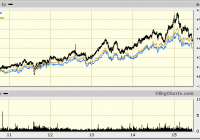Westar Energy: A Progressive Utility With A 3.5% Yield
Summary Westar Energy harnesses wind in Kansas for cheap power. Westar Energy retiring three old coal and gas plants. Westar implemented a $78 million rate increase in October. Westar Energy (NYSE: WR ) is a progressive utility company that is aggressively moving to clean power. Westar Energy plans to nearly double its clean power while reducing fossil fuel energy by 7%. In my previous article about Westar Energy, I told investors to buy this stock around $37 per share as the company adds cheap wind power while reducing coal. Kansas has some of the strongest winds in the country. Westar is prepared for tougher environmental regulations from the Clean Power Plan. The Clean Power Plan establishes state-by-state targets for carbon emissions reductions, and it offers a flexible framework under which states may meet those targets. The final version of the rule would reduce national electricity sector emissions by an estimated 32% below 2005 levels by 2030. Westar Energy has sufficient capacity right now to meet demand. But on a conference call with investors, Mark Ruelle, president and chief executive officer, said the investment in wind is primarily because it’s so inexpensive with the tax credits. The move also is a bit of a hedge on what form the Clean Power Plan takes in Kansas. Ruelle said wind energy is a bargain right now. (click to enlarge) Ruelle said Westar Energy has sent out requests for proposals to add another 500 megawatts of power. Right now 9% of Westar’s generation is from renewable resources, but that number will grow to 17% of generation in 2016. Nearly all of this energy will be from wind. Westar Energy’s energy generation mix includes 700 megawatts from wind energy, with commitments to add another 600 megawatts under development for a total of 1,300 megawatts. In addition, Westar is now considering adding another 500 megawatts on top of the 1,300. “We’re continuing to evaluate, but right now it looks like it makes more sense for our customers if we own all of our sizable portion of the incremental renewables,” Ruelle said. “Today our renewables portfolio is heavily imbalanced for PPA (Purchase Power Agreement) vs. ownership and if we don’t re-balance it a bit that might set us and our customers up for problems down the road when the PPAs expire, plus customer economics favor ownership,” Ruelle said. Westar Energy recently announced plans to close three small units at Lawrence, Tecumseh and Hutchinson by the end of the year. These are the first major unit that Westar has closed in the past few decades. The Lawrence and Tecumseh units burn coal, and the Hutchinson one uses natural gas. “It’s been good for our customers to hold on to these small old units as long as we reasonably could, but for a number of reasons, now is the right time to let them go,” Ruelle said. “They have lasted decades longer than anyone ever imagined, some of them are older than me, but given the clean power plan, their age, size and our need to manage expenses, it just doesn’t make sense to pour more money into them. They reflect two small 50s and early 60s vintage COLI units and a 60s vintage gas steamer. Together they are just 350 megawatts and less than 1% of plant investment.” Third quarter Westar Energy’s third quarter was sluggish. Cool-to-mild temperatures in August hurt demand for electricity. Westar Energy posted 3Q15 earnings of $138.2 million or $0.97 per share, compared with $146.9 million or $1.13 per share in 3Q14. Earnings for the nine-month period ended Sept. 30, 2015, were $253.4 million or $1.84 per share, compared with $270.3 million or $2.08 per share for the same period in 2014. The company has narrowed its 2015 earnings guidance range to $2.18-$2.25 per share from $2.18-$2.33. The company issued preliminary 2016 earnings guidance of $2.38-$2.53 per share. The company has strong financial strength. The company’s debt is investment grade. Total long-term debt was $2.941 billion at the end of 3Q15, compared to $3.224 billion at the end of 2014. The stock trades around 18.8 times earnings, which is a slight premium to its peers. Westar will see earnings improve in the fourth quarter and in 2016 due to implementation of a $78 million rate increase, approved by the Kansas Corporation Commission. Risks Utilities are sensitive to interest rates. When the Federal Reserve begins raising interest rates, these stocks are likely to take a hit. Utilities had a nice run up in 2014, but haven’t performed well in 2015. The Utilities Select Sector SPDR Fund (NYSEARCA: XLU ) is down -9.47% YTD. Westar stock has held up fairly well in 2015, down only -1.14% YTD. Ruelle said one large chemical producer had reduced consumption of electricity due in part to the low prices for oil. I believe we are near a bottom in oil but the price recovery will be slow and arduous. Weather is always a factor with utilities. Westar benefits from extremely hot temperatures in the summer and really cold temperatures in the winter. 2015 was mild to moderate most of the year in Kansas. Conclusion If Westar falls into the high $30s again, investors may want to consider buying the stock. Westar is a well-run utility with strong financials and steady income. The stock offers a yield of 3.5% with potential for modest appreciation. I bought WR at $37.03 on Aug. 27, 2015. The stock recently traded at $41.32 per share, a gain of 11.58% plus the gain from the $0.36 dividend for a total gain of 12.55%. I’m holding o nto the stock. Long-term investors will get the dividend and likely modest appreciation with a 12-month target price of $44.
